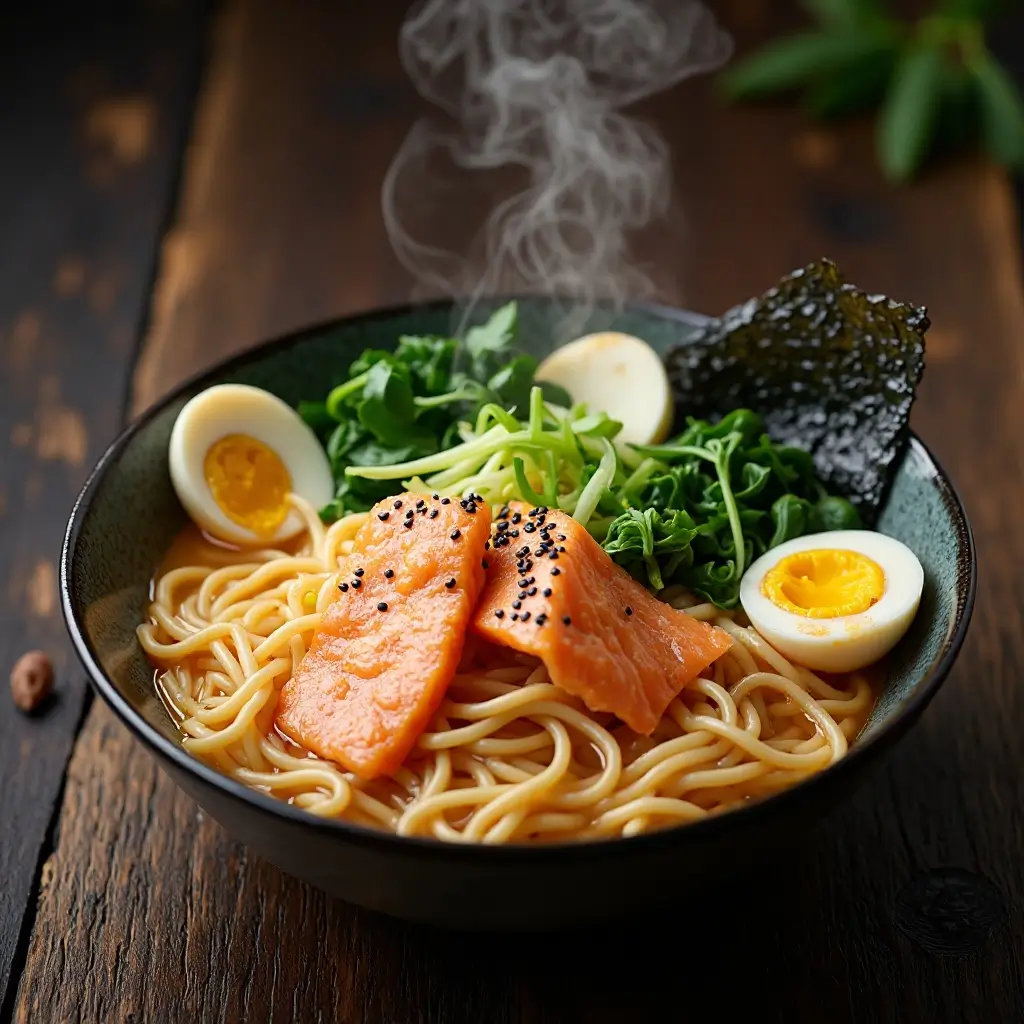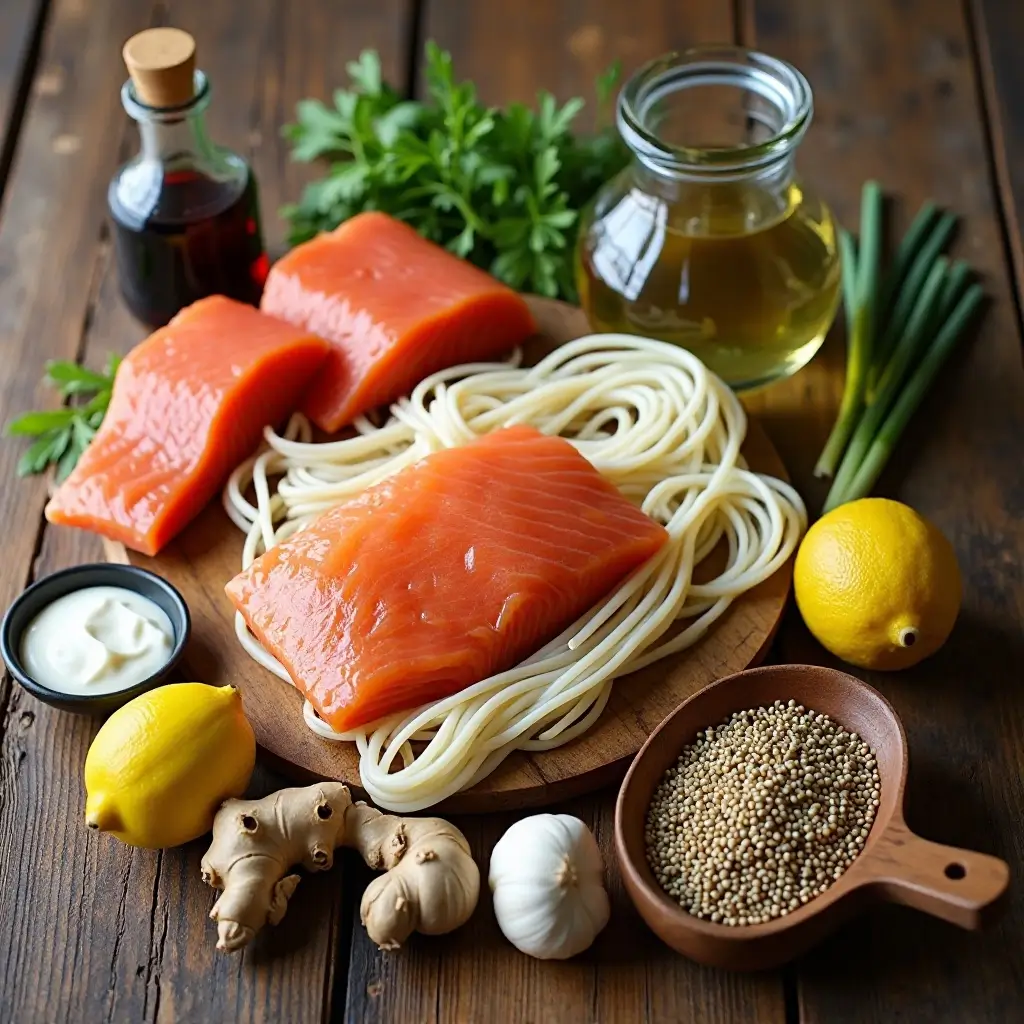Quick Salmon Udon Ready in 25 Minutes
Craving something warm, satisfying, and absolutely delicious? This creamy salmon udon combines tender flaky salmon with silky udon noodles in a rich, savory broth that’s ready in just 20 minutes. Here’s a fun fact: udon noodles were originally brought to Japan by Buddhist monks over 1,000 years ago!
This dish perfectly marries Japanese tradition with modern convenience, making it ideal for busy weeknight dinners when you want restaurant-quality flavor without the fuss.
Just like our popular chicken teriyaki bowl, this salmon udon proves that incredible meals don’t require hours in the kitchen. Get ready to fall in love with your new favorite comfort food!
Table of Contents
What is Salmon Udon?
Ever wondered why we call thick, chewy noodles swimming in savory broth with flaky salmon “udon”? Well, udon literally means “hand-cut noodles” in Japanese – though don’t worry, we’re using store-bought ones today!
Legend says these hearty noodles were created when a monk wanted something more filling than regular pasta. And you know what they say: “the way to a man’s heart is through his stomach” – this dish definitely proves that point! Ready to create some noodle magic in your own kitchen?
Why You’ll Love This Salmon Udon
Rich, Restaurant-Quality Flavor at Home
This salmon udon delivers that luxurious, restaurant-style taste you crave without breaking the bank. The combination of buttery salmon, umami-rich miso broth, and perfectly chewy udon noodles creates a harmony of flavors that rivals any high-end Japanese restaurant. Each bite offers layers of complexity – from the caramelized salmon skin to the silky broth that coats every strand of noodle.
Budget-Friendly Comfort Food
Making this salmon udon at home costs a fraction of ordering takeout, yet tastes infinitely better. A single salmon fillet stretches beautifully to serve multiple people when paired with hearty udon noodles and vegetables. You’ll save money while treating your family to a gourmet experience that typically costs $15-20 per bowl at restaurants.
Customizable and Family-Friendly
The beauty of this recipe lies in its flexibility. Add vegetables like bok choy, mushrooms, or corn to boost nutrition. Adjust the spice level for different family members. Kids love the mild, comforting flavors, while adults can amp up the heat with chili oil. Just like our beloved ramen carbonara recipe, this dish adapts to everyone’s preferences. Why not give this cozy bowl a try tonight?

How to Make Salmon Udon
Quick Overview
This salmon udon recipe is incredibly straightforward and perfect for beginners. The key to success lies in properly searing the salmon for that golden crust while keeping the interior tender and flaky. The rich, savory broth comes together quickly using pantry staples like miso paste and soy sauce.
Prep Time: 10 minutes
Cook Time: 15 minutes
Total Time: 25 minutes
Servings: 4
Key Ingredients for Salmon Udon
For the Salmon:
- 1 lb salmon fillet, skin removed, cut into 4 portions
- 2 tablespoons vegetable oil
- 1 teaspoon salt
- 1/2 teaspoon black pepper
For the Broth:
- 4 cups chicken or vegetable stock
- 3 tablespoons white miso paste
- 2 tablespoons soy sauce
- 1 tablespoon mirin
- 1 teaspoon sesame oil
- 2 cloves garlic, minced
- 1 inch fresh ginger, grated
For Assembly:
- 4 portions fresh udon noodles (or 12 oz dried)
- 2 green onions, sliced thin
- 1 sheet nori, cut into strips
- 2 soft-boiled eggs, halved
- 1 cup baby spinach
- Sesame seeds for garnish

Step-by-Step Instructions
Step 1: Prepare the Salmon Season salmon fillets with salt and pepper on both sides. Heat vegetable oil in a large skillet over medium-high heat. Once hot, add salmon skin-side down if using skin-on fillets. Cook for 4-5 minutes until golden brown and crispy. Flip and cook another 3-4 minutes until just cooked through. Remove from heat and flake into large chunks.
Step 2: Make the Aromatic Broth In a large pot, heat sesame oil over medium heat. Add minced garlic and grated ginger, cooking for 30 seconds until fragrant. Whisk in miso paste until smooth, then gradually add stock while whisking continuously. Bring to a gentle simmer and add soy sauce and mirin. Taste and adjust seasoning as needed.
Step 3: Cook the Udon Noodles If using fresh udon, rinse under cold water and separate gently. For dried udon, cook according to package directions until just tender. Fresh udon only needs 2-3 minutes in boiling water. Drain thoroughly and divide among four serving bowls.
Step 4: Assemble Your Bowls Ladle the hot broth over the udon noodles in each bowl. Top with flaked salmon, baby spinach (it will wilt from the heat), halved soft-boiled eggs, and sliced green onions. Garnish with nori strips and sesame seeds. Serve immediately while hot.
What to Serve Salmon Udon With
This hearty salmon udon is satisfying enough to stand alone, but these sides create a complete Japanese-inspired meal:
Appetizers: Start with gyoza (pan-fried dumplings) or a simple cucumber salad dressed with rice vinegar and sesame oil. Miso soup with tofu and wakame seaweed also makes an excellent first course.
Vegetables: Serve alongside sautéed bok choy with garlic, roasted Brussels sprouts with soy glaze, or quick-pickled vegetables for a refreshing contrast to the rich broth.
Drinks: Green tea, cold sake, or Japanese beer like Sapporo complement the umami flavors beautifully. For non-alcoholic options, try iced oolong tea or sparkling water with yuzu.
Top Tips for Perfecting Salmon Udon
Don’t Overcook the Salmon
The key to perfect salmon udon is achieving that golden, crispy exterior while keeping the fish moist and flaky inside. Remove salmon from heat as soon as it reaches 145°F internal temperature. The residual heat will finish cooking it as you assemble the bowls.
Quality Miso Makes a Difference
Invest in good-quality white (shiro) miso paste for the smoothest, most balanced flavor. Avoid red miso for this recipe as it can be too salty and overpowering. Always whisk miso paste with a small amount of warm stock before adding to prevent lumps.
Fresh Udon vs. Dried
Fresh udon noodles from the refrigerated section have the best texture – chewy and bouncy. If using dried udon, don’t overcook them as they’ll continue softening in the hot broth. Rinse cooked noodles briefly under cold water to stop the cooking process.
Customize Your Toppings
Make this recipe your own by adding corn kernels, sliced mushrooms, bamboo shoots, or bean sprouts. A drizzle of chili oil or sprinkle of shichimi togarashi (Japanese seven spice) adds wonderful heat for spice lovers.
Storing and Reheating Tips
Refrigerator Storage: Store leftover components separately for best results. The broth keeps for 3-4 days in the refrigerator, while cooked salmon stays fresh for 2-3 days. Cooked udon noodles can be stored for 2 days but may become softer.
Freezing Instructions: The broth freezes beautifully for up to 3 months in freezer-safe containers. Cooked salmon can be frozen for 2-3 months, though the texture may change slightly. Avoid freezing cooked udon noodles as they become mushy when thawed.
Reheating Method: Reheat broth gently on the stovetop, whisking occasionally. Warm salmon in the microwave for 30-60 seconds or in a low oven. Cook fresh udon noodles when ready to serve rather than reheating leftover noodles for the best texture.
Make-Ahead Tips: Prepare the broth up to 2 days ahead and store in the refrigerator. Cook salmon the day you plan to serve for optimal freshness and texture.
Nutritional Information
| Nutrient | Per Serving |
|---|---|
| Calories | 485 |
| Protein | 28g |
| Carbohydrates | 52g |
| Fat | 18g |
| Fiber | 3g |
| Sodium | 1,240mg |
| Omega-3 | 1.2g |
Values are approximate and may vary based on specific ingredients used
Frequently Asked Questions
Can I use frozen salmon for this recipe?
Yes, but thaw it completely first and pat dry thoroughly before cooking. Frozen salmon may release more moisture during cooking, so increase cooking time slightly to achieve proper browning.
What’s the best substitute for miso paste?
If you can’t find miso paste, substitute with 2 tablespoons soy sauce plus 1 tablespoon tahini or peanut butter for depth. The flavor won’t be identical but will still be delicious.
How do I know when salmon is perfectly cooked?
Salmon is done when it flakes easily with a fork and reaches an internal temperature of 145°F. The flesh should be opaque throughout with a slightly pink center.
Can I make this recipe vegetarian?
Absolutely! Replace salmon with pan-fried tofu or mushrooms, and use vegetable stock instead of chicken stock. Add extra vegetables like corn and spinach for substance.
Why is my broth cloudy?
Cloudy broth usually results from boiling too vigorously. Keep the broth at a gentle simmer, and whisk miso paste thoroughly to prevent lumps that can cloud the liquid.
How long do soft-boiled eggs take to make?
Bring water to a boil, gently add eggs, and cook for exactly 6-7 minutes. Immediately transfer to ice water to stop cooking. This creates the perfect runny yolk consistency.
Additional Recipe Variations
Spicy Salmon Udon: Add 1-2 teaspoons of gochujang or sriracha to the broth for heat. Top with sliced jalapeños and a drizzle of chili oil.
Creamy Coconut Salmon Udon: Replace half the stock with coconut milk for a rich, creamy variation. Add a squeeze of lime juice before serving.
Teriyaki Salmon Udon: Glaze the salmon with teriyaki sauce while cooking for extra sweetness and umami depth.
This salmon udon recipe brings restaurant-quality Japanese comfort food to your home kitchen. The combination of perfectly cooked salmon, chewy udon noodles, and rich savory broth creates a meal that’s both satisfying and sophisticated. Whether you’re cooking for family dinner or impressing guests, this recipe delivers every time. The best part? It’s ready in just 25 minutes, making it perfect for busy weeknights when you want something special without the fuss.
